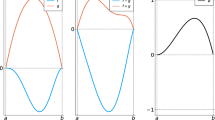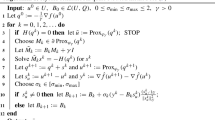Abstract
In this paper, we consider minimal time problems governed by control-affine-systems in the plane, and we focus on the synthesis problem in presence of a singular locus that involves a saturation point for the singular control. After giving sufficient conditions on the data ensuring occurrence of a prior-saturation point and a switching curve, we show that the bridge (i.e., the optimal bang arc issued from the singular locus at this point) is tangent to the switching curve at the prior-saturation point. This property is proved using the Pontryagin Maximum Principle that also provides a set of non-linear equations that can be used to compute the prior-saturation point. These issues are illustrated on a fed-batch model in bioprocesses and on a Magnetic Resonance Imaging (MRI) model for which minimal time syntheses for the point-to-point problem are discussed.




Similar content being viewed by others
Notes
Here, \(N_{\mathcal{T}}(x)\) stands for the (Mordukovitch) limiting normal cone to \(\mathcal{T}\) at point \(x\in \mathcal{T}\), see [28]. It coincides with the normal cone in the sense of convex analysis when \(\mathcal{T}\) is convex.
By optimally invariant subset, we mean a subset \(\Omega \subset \mathbb{R}^{2}\) such that for any initial condition \(x_{0}\in \Omega \), an optimal trajectory stays in \(\Omega \).
Following for instance [24, Sect. 2.8.4], chattering occurs for singular arcs of higher order (at least 2) for which the Legendre-Clebsch condition is not fulfilled.
Since \(\mathcal{T} :=\{x_{f}\}\) is a point, there is no transversality condition at the terminal time.
In contrast with the previous sections in which state variables are \((x_{1},x_{2})\), we chose to adopt the notation \((s,v)\) that is commonly used in the bioprocesses literature for fed-batch operations.
Micro-organism concentration \(X>0\) can be expressed as a simple function of \((s,v)\), namely \(X=M/v+s_{\mathit{in}}-s\), thus (5.1) is enough to describe a bioreactor operated in fed-batch mode.
References
Bayen, T., Gajardo, P., Mairet, F.: Optimal synthesis for the minimum time control problems of fed-batch bioprocesses for growth functions with two maxima. J. Optim. Theory Appl. 158, 521–553 (2013)
Bayen, T., Harmand, J., Sebbah, M.: Time-optimal control of concentration changes in the chemostat with one single species. Appl. Math. Model. 50, 257–278 (2017)
Bayen, T., Mazade, M., Mairet, F.: Analysis of an optimal control problem connected to bioprocesses involving a saturated singular arc. Discrete Contin. Dyn. Syst., Ser. B 20, 39–58 (2015)
Bayen, T., Rapaport, A., Sebbah, M.: Minimal time control of the two tanks gradostat model under a cascade input constraint. SIAM J. Control Optim. 52, 2568–2594 (2014)
Bernard, O., Hadj-Sadok, Z., Dochain, D., Genovesi, A., Steyer, J.-P.: Dynamical model development and parameter identification for an anaerobic wastewater treatment process. Biotechnol. Bioeng. 75, 424–438 (2001)
Bonnard, B., Chyba, M.: Singular Trajectories and Their Role in Control Theory. Mathématiques & Applications (Berlin) [Mathematics & Applications], vol. 40. Springer, Berlin (2003)
Bonnard, B., Drouot, J.: Towards Geometric Time Minimal Control without Legendre Condition and with Multiple Singular Extremals for Chemical Networks. arXiv:2001.04126
Bonnard, B., Kupka, I.: Generic properties of singular trajectories. Ann. Inst. Henri Poincaré, Anal. Non Linéaire 14(2), 167–186 (1997)
Bonnard, B., Claeys, M., Cots, O., Martinon, P.: Geometric and numerical methods in the contrast imaging problem in nuclear magnetic resonance. Acta Appl. Math. 135, 5–45 (2015)
Bonnard, B., Cots, O., Rouot, J., Verron, T.: Time minimal saturation of a pair of spins and application in magnetic resonance imaging. In: Math. Control Related Fields (2019)
Bonnard, B., Cots, O., Glaser, S., Lapert, M., Sugny, D., Zhang, Y.: Geometric optimal control of the contrast imaging problem in nuclear magnetic resonance. IEEE Trans. Autom. Control 57, 1957–1969 (2012)
Bonnard, B., De Morant, J.: Toward a geometric theory in the time-minimal control of chemical batch reactors. SIAM J. Control Optim. 33, 1279–1311 (1995)
Bonnard, B., Pelletier, M.: Time minimal synthesis for planar systems in the neighborhood of a terminal manifold of codimension one. J. Math. Syst. Estim. Control 5, 22 (1995)
Boscain, U., Piccoli, B.: Optimal Syntheses for Control Systems on 2-D Manifolds. Mathématiques & Applications (Berlin) [Mathematics & Applications], vol. 43. Springer, Berlin (2004)
Hermes, H., LaSalle, J.: Functional Analysis and Time Optimal Control. Mathematics in Science and Engineering, vol. 56. Academic Press, New York/London (1969)
Kalboussi, N., Rapaport, A., Bayen, T., Amar, N.B., Ellouze, F., Harmand, J.: Optimal control of membrane-filtration systems. IEEE Trans. Autom. Control 64, 2128–2134 (2019)
Ledzewicz, U., Schättler, H.: Antiangiogenic therapy in cancer treatment as an optimal control problem. SIAM J. Control Optim. 46, 1052–1079 (2007)
Levitt, M.: Spin Dynamics: Basics of Nuclear Magnetic Resonance. Wiley, New York (2008)
Moreno, J.: Optimal time control of bioreactors for the wastewater treatment. Optim. Control Appl. Methods 20, 145–164 (1999)
Piccoli, B.: Classification of generic singularities for the planar time-optimal synthesis. SIAM J. Control Optim. 34, 1914–1946 (1996)
Pontryagin, L.S., Boltyanskii, V.G., Gamkrelidze, R.V., Mishchenko, E.F.: The Mathematical Theory of Optimal Processes. A Pergamon Press Book. The Macmillan Co., New York (1964). Translated by D.E. Brown
Rapaport, A., Bayen, T., Sebbah, M., Donoso-Bravo, A., Torrico, A.: Dynamical modeling and optimal control of landfills. Math. Models Methods Appl. Sci. 26, 901–929 (2016)
Schättler, H., Jankovic, M.: A synthesis of time-optimal controls in the presence of saturated singular arcs. Forum Math. 5, 203–241 (1993)
Schättler, H., Ledzewicz, U.: Geometric Optimal Control. Interdisciplinary Applied Mathematics, vol. 38. Springer, New York (2012)
Sussmann, H.J.: Regular synthesis for time-optimal control of single-input real analytic systems in the plane. SIAM J. Control Optim. 25, 1145–1162 (1987)
Sussmann, H.J.: The structure of time-optimal trajectories for single-input systems in the plane: the \(C^{\infty }\) nonsingular case. SIAM J. Control Optim. 25, 433–465 (1987)
Sussmann, H.J.: The structure of time-optimal trajectories for single-input systems in the plane: the general real analytic case. SIAM J. Control Optim. 25, 868–904 (1987)
Vinter, R.: Optimal Control, Systems & Control: Foundations & Applications. Birkhäuser Boston, Inc., Boston (2000)
Acknowledgements
We are very grateful to E. Trélat for helpful discussions and suggestions about the tangency property at the prior-saturation point.
Author information
Authors and Affiliations
Corresponding author
Additional information
Publisher’s Note
Springer Nature remains neutral with regard to jurisdictional claims in published maps and institutional affiliations.
Rights and permissions
About this article
Cite this article
Bayen, T., Cots, O. Tangency Property and Prior-Saturation Points in Minimal Time Problems in the Plane. Acta Appl Math 170, 515–537 (2020). https://doi.org/10.1007/s10440-020-00344-8
Received:
Accepted:
Published:
Issue Date:
DOI: https://doi.org/10.1007/s10440-020-00344-8




